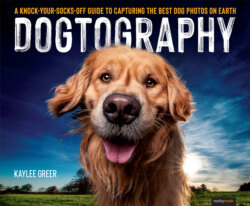Читать книгу Dogtography - Kaylee Greer - Страница 16
IT’S ALL IN THE APPROACH
ОглавлениеPicture this. You show up to your shoot at a park on a beautiful sunny afternoon. As soon as you’ve gathered your gear, you spot your client and their dog (to help fully form this scene in your imagination, let’s say the dog is a chocolate lab named Hank). Hank is, of course, beautiful, and your instinct is to sprint full speed toward him because you’ve secretly chosen to become a dog photographer simply to cuddle more dogs (it’s possible I’m projecting here).
Well, as the saying goes, first impressions are everything. From the moment that you enter into that dog’s world, you are setting the tone for the energy of the rest of your day together. Approaching a new dog directly, flail your arms wildly with too-frantic energy and repeatedly screaming “I want to squish your head off your body!” is not a great idea if you want to kick things off on the right foot.
1.4
FIGURE 1.4 While documenting stray and street dogs in Costa Rica for a special project awareness series, my partner Sam and I encountered this timid, weatherworn pup in a lonely parking lot. In a situation like this, approach becomes incredibly important. Our human body language and energy may either draw the dog in, or reinforce pre-existing fears that he may have about human beings. Sam’s very soft, gentle, nonconfrontational body language in this photo I snapped of him meeting this sweet, stray soul is a very good visual example of a successful and respectful approach to a new dog. (As a note, if this photo bums you out, I highly recommend you get out there and volunteer at one of the thousands of shelters in the world who could desperately use your help to make a difference in the lives of forgotten dogs like this one.)
You may notice that two unacquainted dogs never approach each other in a straight line unless they’re looking for a fight. As a rule, dogs always politely circle or approach one another indirectly after they’ve taken a nice, wide berth. Keep this in mind and apply dog rules in order to make an approach in the most respectful way possible.
Take a deep breath and calmly approach the owner, speaking to only them while mostly ignoring the dog. Hold your hand out palm down and allow the dog to sniff you to his heart’s content. If the dog is approved to have a treat, calmly treat him without getting down on his level.
After a minute or two, you’ll probably be able to sense the dog’s level of confidence. If the dog seems calm, get down on his level and allow him to investigate you. If the dog still seems hesitant, just give him time. Every dog is different, and while some will warm up right away, others are a bit more skeptical when it comes to new people. If I know I am going into a shoot with a fearful dog, I’ll build in extra time so that I can make this introduction stage as long as necessary. In past extreme cases, I’ve waited over an hour before ever attempting to bring out any camera gear in order to give the dog as much time as possible to be comfortable and reach a state of calm.
The owner may be hesitant to let their dog too close to your expensive camera equipment, but assure them that it’s important for their dog to sniff all of the strange instruments that are about to be shoved into their personal space. (Oh, a prerequisite for being a dog photographer? You can’t be too dainty about your gear.) Put everything that you’ve brought with you down on the ground.
While approaching dogs is likely not a concept that’s entirely new to you, here’s a quick list of important points to remember to make your next photo shoot go as smoothly and successfully as possible from the beginning:
Do not approach in a direct, straight line.
Do not make immediate, direct eye contact.
Do not lean or tower over the dog’s head.
Scratch the rear end or underside of the dog’s chin; not the top of his head!
No kissing or hugging (yes, this is very, very hard for me, thanks for asking).
Get low, on the dog’s level (please note, if you sense aggression of any kind, give the dog space rather than getting on his level).
Put all large objects (e.g., photography gear) on the ground before making your approach.
Speak in a soft voice while controlling your energy—keep it calm and even.
Respect their space, read their body language, and do not corner them. Always leave an escape route and let them take it if they choose to move away.
Give plenty of opportunity to sniff! You, your bags, your gear, and the wagon you may have brought to cart it all around in!
I’ve seen (and experienced firsthand) the wrong style of approach throw off an entire photo shoot from go. Successfully approaching your dog model will start your shoot off on the right foot and set a positive precedent for the rest of the day. So, now that you’ve got that down, what’s next?
